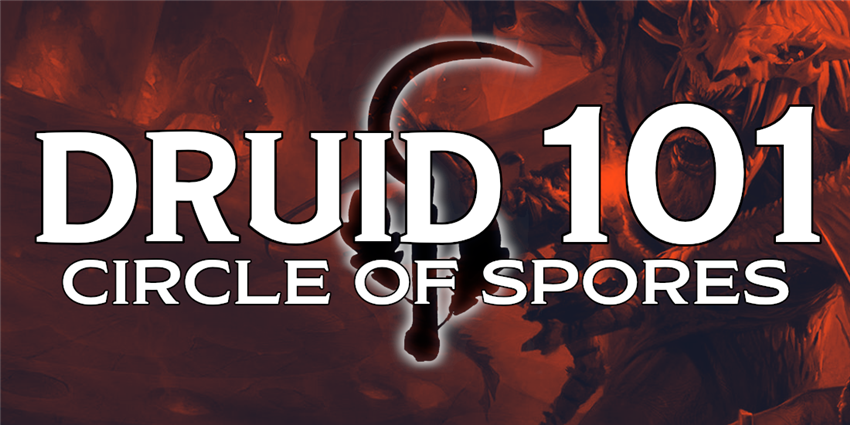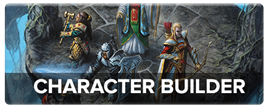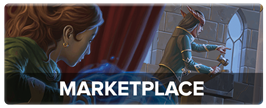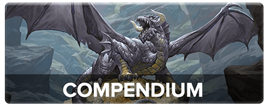We’ve completed our second full rotation of the twelve classes in the Player’s Handbook, not to mention taken a deep dive into the first 5 levels of D&D’s thirteenth class, the inventive and arcane Artificer! This wave of the Class 101 series will appraise every subclass within the Player’s Handbook and break down each subclass’s strengths, weaknesses, thematic elements, and everything else a player would want to know before playing that subclass. Because of this, you will need to own the Player’s Handbook (or purchase the subclass a la carte on the Marketplace) in order to make full use of this series.
However, since there are some classes that only have two subclasses in the Player’s Handbook, we’ll need to go beyond that must-have book to other optional D&D sources. The druid is one such class—their next subclass is the Circle of Spores, which can be found in Guildmaster’s Guide to Ravnica, a campaign setting that allows you to play D&D campaigns on the urban city-plane of Ravnica from Magic: The Gathering.

The druidic Circle of Spores is unique to the Golgari Swarm, one of the ten guilds that shapes life on Ravnica. However, druids of decay can be found in many D&D settings, as decay is just as important a form of life as growth. They may not be as popular as druids who work in Circles of the Land or of the Moon, thanks to their unseemly association with death, but they are an important part of the ecosystem nonetheless. Moreover, they’re just as likely to be devoted to protecting the natural balance of the world as their more friendly counterparts.
If you don’t own Guildmaster’s Guide to Ravnica, but want to play a Circle of Spores druid after reading this class guide, you can buy just this subclass a la carte by scrolling down on the Guildmaster’s Guide to Ravnica product page in the D&D Beyond Marketplace.
Check out the other guides in the Class 101 series, like the broad overview of the druid class in Druid 101: A Beginner’s Guide to Channeling Nature’s Might, Druid 101: Circle of the Land, Druid 101: Circle of the Moon, and Druid 101: Wildshape Guide. If you’re interested in playing other classes, check out the entire Class 101 series.
Story of the Circle of Spores
A massive elephant-like humanoid—a loxodon—kneeled in a pool of brackish water. The pool was choked with algae, and a single shaft of sunlight glinted off the pool. The sun could barely penetrate the thick canopy of stone and metal in this abandoned neighborhood, and the building that the druid was kneeling in was akin to the stump of a tree torn down by wind. It was broken and ugly, but it could still be a home for new life.
The loxodon wore green and black robes, the colors of the Golgari Swarm. Her kind were rare among the humans and elves of the Golgari, but it wasn’t unheard of for loxodon to break from the ranks of the Selesnya Enclave and embrace the darker side of nature. Nevertheless, she had a warm smile upon her face as she stared at the bloated corpse half-floating in the stagnant pool. She traced her hand in lazy circles over the dead man’s chest and hummed a dreary little tune to herself.
Rot, rot, rot away…
The corpse’s flesh deteriorated rapidly.
Don’t matter who you were yesterday…
The rotten bones began to collapse into the pool.
Be it crook or crone or crow…
She slowly drew her hand upward, still circling, and dozens of mushrooms of all shapes, colors, and sizes bloomed out of the corpse’s ribs.
All that’s left to do… is grow.
The freshly grown mushrooms all exhaled a cloud of fluffy spores, and the druid stood with a grunt and giggled. “This’ll be a Golgari neighborhood soon ‘nuff!” she said to herself. “Go on li’l spores, let’s grow wild!”
Circle of Spores Features
The Circle of Spores draws upon the natural power of decay and regrowth to fuel their magic, granting them sinister spells, and the ability to use their Wild Shape abilities to power other features instead of transforming into beast form. The druid gains access to four subclass features at 2nd, 6th, 10th, and 14th level. You can read all of the Circle of Spores features in chapter 1 of Guildmaster’s Guide to Ravnica. In summary, your subclass features allow you to:
- Lash out with a halo of toxic spores when foes approach you.
- Channel the power of your Wild Shape into empowering symbiotic spores that live within your body.
- Animate corpses with the power of your living spores.
- Spread your halo of toxic spores to a distant area.
- Overcome the limitations of your physical body by altering yourself with your symbiotic spores.

Benefits of the Circle of Spores
The Circle of Spores druid has a strong thematic identity which dovetails with a unique and unusual mechanical role in the party. Rather than blasting enemies from afar with spells, supporting allies with buffs and healing magic, or transforming into beasts to maul foes in close combat, this subclass allows you to pump your body full of magical spores and symbiotic entities to fortify you and improve your own melee damage output. This comes with an added benefit—whereas most druids can’t cast spells while transformed, your Wild Shape doesn’t transform you, leaving you free to benefit from both your spells and your Symbiotic Entity at once.
The usual suite of druid spells gives you a strong base of ranged magic power (plus your 10th level feature, Spreading Spores, gives you an additional burst of ranged territory control damage), but your Circle of Spores subclass features improve your melee potential by converting Wild Shape uses into personal buffs to both damage and temporary hit points. Your melee abilities aren’t quite comparable to melee-focused “half-casters” like paladins, but when combined with the shillelagh cantrip, this subclass makes you just as formidable as close-range spellcasters like College of Valor bards or War Domain clerics.
Drawbacks of the Circle of Spores
Your Symbiotic Entity feature is a core benefit of the Circle of Spores. It allows you to gain personal buffs by expending uses of your Wild Shape feature, rather than transforming into a beast form. One of the biggest drawbacks of the Circle of Spores is in comparison to the fearsome power of the Circle of the Moon at low levels. Using their Combat Wild Shape feature, Circle of the Moon druids can effectively double their hit points with every use of Wild Shape, turning them into unkillable killing machines.
Of course, this drawback becomes less and less pronounced as you level up—primarily because Circle of the Moon druid’s Combat Wild Shape feature wanes in power as they level up, whereas your subclass features tend to keep pace.
Your Fungal Infestation feature allows you to raise beasts or humanoid corpses as zombies. Despite the efficiency of this feature, you gain this feature at 6th level, a point at which a CR 1/4 zombie probably won’t contribute much to combat. Its attacks, defenses, and movement are all easily ignored by foes, meaning that it’s best use is as an extra body on the field to help rogues gain Sneak Attack. It can only take the Attack action, but its best use may be using that action to make a special attack like grappling or shoving a creature. Forcing or restricting another creature's movement may be more useful to you than a single attack's worth of damage. Unlike a wizard or warlock’s familiar, however, the zombie’s slow movement and lack of flight makes it hard to get into position.
Nevertheless, it’s a good sign that the Circle of Spores’ drawbacks are primarily in comparison to other classes, rather than any sort of inherent shortcoming of their own. This is a very fun subclass for anyone seeking to play an eerie (but not necessarily evil) nature-loving character.

Suggested Build
If you’re planning on choosing the Circle of Spores once you become a 2nd-level druid, you should choose a race that grants you a bonus to Wisdom, like a wood elf or hill dwarf. Both of these races already have a natural connection to the land itself, and thematically match the class, making them a perfect fit! If you’re playing a character in the Ravnica setting, Circle of Spores druids are strongly associated with the Golgari Swarm, a guild whose members are primarily humans or dark elves. That said, characters of any race can find a home in any guild—like in the Story section earlier in this article, members of the loxodon race are excellent choice, as are centaurs and Simic hybrids.
Since you’re going to be a front-line or mid-rank combatant, and you’re not going to be using your Wild Shape feature to transform, it’s best to put your highest ability score in Wisdom (to improve your spellcasting power and the offensive power of your shillelagh attacks) and your second-highest score in Dexterity (to improve your Armor Class and ranged attacks). Improving Strength or Constitution instead of Dexterity is also a valid choice, especially if you chose a race that grants you a bonus to either of those ability scores.
As usual, your character’s background is up to you. However, if you’re playing in Ravnica, it’s best to choose a background that supports your guild affiliation, as described in chapter 2 of Guildmaster’s Guide to Ravnica. The Golgari Agent background makes the most sense for a Circle of Spores druid, but with an interesting backstory, you could conceivably belong to another guild that has an affinity for nature, such as the Selesnya Conclave, the Gruul Clans, or the Simic Combine.
Selecting EQUIPMENT when building a 1st-level druid will make your life easier, as most druids don’t have to worry too much about what equipment they carry. Fortunately, your spell selection is more important to your continued survival than your equipment selection, so just choose whatever tools you think would be useful.
Optional: Environment
If your gaming group owns a copy of Xanathar’s Guide to Everything, what kind of biome your druid grew up in could play a role in what Wild Shape forms you know from the beginning of the game. If you don’t own this book, you and your DM can simply discuss what Wild Shape options you have access to starting at 2nd level. Your druid’s environment is described in chapter 1 of Xanathar’s Guide to Everything, and you can choose from any of the options listed. Of course, if you’re playing in Ravnica, you’re most likely only familiar with a single environment: the vast city-plane of Ravnica.

Spells
You don’t choose your subclass until 2nd level, but you can still carve out your role in the party through your spell selection before you officially join the Circle of Spores. Like a cleric, you have your entire class spell list available to you whenever you prepare spells at the start of the day. Nevertheless, when playing a druid, it can help to have a typical spell list that your druid always has prepared—unless you specifically choose otherwise. This can save you the trouble of having to re-select all your spells at the start of each day. Your Circle Spells also grant you a mix of combat and utility spells, so you may want to gear your spell selection towards spells that will help you in social or exploration scenarios.
As a 1st-level druid, you know two cantrips and can prepare a number of 1st-level spells equal to 1 + your Wisdom modifier. Odds are, your Wisdom modifier will be either +2 or +3 right now, so you’ll be able to choose either three or four 1st-level spells whenever you complete a long rest. Since you’re going to be in the thick of combat, using your Halo of Spores and Symbiotic Entity features to deal damage, having a melee cantrip like shillelagh is vital to your survival. Produce flame is also a good choice, since it can serve as both ranged offense and utility. Beyond this, your cantrips are simply a matter of preference, and almost any will serve you well. Druidcraft is another good first choice, since it lets you perform all manner of minor, “druid-y” tricks.
You can prepare any 1st-level spells from the druid spell list, but you can use this list of suggested spells to prepare an all-purpose spell loadout that will serve you in most circumstances. As you go on adventures and learn what dangers your character tends to face, you can personalize your spell loadout. Try to choose one spell labeled SUPPORT and two labeled UTILITY. If you have a high Wisdom score and can prepare additional spells, choose others of your choice. Note that this list only includes some spells from the Player's Handbook, so if you want to choose more unusual spells, or have other sources like Xanathar's Guide to Everything, you'll have to do a little self-directed research. This list is just here to get you started if this is your first time playing a Circle of Spores druid.
Be warned that many druid spells require concentration, and you can only concentrate on one spell at once. Try to limit the number of concentration spells you prepare to no more than 1/3 of your spell loadout on any given adventuring day. To aid in this, all concentration spells on this list are listed as such.
- Animal friendship (DEFENSE/UTILITY)
- Charm person (SOCIAL)
- Detect magic (UTILITY)
- Entangle (DEFENSE; CONCENTRATION)
- Faerie fire (SUPPORT; CONCENTRATION)
- Fog cloud (DEFENSE; CONCENTRATION)
- Healing word (SUPPORT)
- Speak with animals (UTILITY)
- Thunderwave (COMBAT)

Feats
Once you’ve improved your Wisdom score to 18 or 20, you can increase your power with a few useful feats. The following feats are good picks for Circle of Spores druids, and will improve your reliability in your own desired area of expertise:
Elemental Adept (Homebrew Poison). Since your subclass features grant you a lot of poison damage, you may run into the unfortunate situation where your poison damage is resisted by dwarves, duergar, many plants, and certain fiends, it might be worth asking your DM if you can take a homebrew version of the Elemental Adept feat that applies to poison damage instead of an elemental damage type.
Healer. You may prefer to spend your spell slots on destructive magic, rather than healing spells. In that case, this feat will help you conserve low-level spell slots by healing with a healer’s kit instead of cure wounds.
Observant. This feat is essentially half a feat, since its effects are minor, and you also gain a +1 bonus to Wisdom when you choose it. Since Wisdom is your key ability score, this +1 can help. Perception is also a crucial skill for just about anyone.
Sentinel. Since you’re a melee fighter and a close-range spellcaster, you can take this feat to become a powerful defender.
If you want more advice for building a druid, check out Druid 101. Have you ever played a Circle of Spores druid? What advice would you give to players that want to make a character like this? Next week, Class 101 will cover the fighter's Eldritch Knight archetype, a warrior who wields weapons and to great destructive potential. What's your druid character like? Let us know in the comments!
Create A Brand-New Adventurer Acquire New Powers and Adventures Browse All Your D&D Content
 James Haeck is the lead writer for D&D Beyond, the co-author of Waterdeep: Dragon Heist, Baldur's Gate: Descent into Avernus, and the Critical Role Explorer's Guide to Wildemount, a member of the Guild Adepts, and a freelance writer for Wizards of the Coast, the D&D Adventurers League, and other RPG companies. He lives in Seattle, Washington with his fiancée Hannah and their animal companions Mei and Marzipan. You can find him wasting time on Twitter at @jamesjhaeck.
James Haeck is the lead writer for D&D Beyond, the co-author of Waterdeep: Dragon Heist, Baldur's Gate: Descent into Avernus, and the Critical Role Explorer's Guide to Wildemount, a member of the Guild Adepts, and a freelance writer for Wizards of the Coast, the D&D Adventurers League, and other RPG companies. He lives in Seattle, Washington with his fiancée Hannah and their animal companions Mei and Marzipan. You can find him wasting time on Twitter at @jamesjhaeck.











-
View User Profile
-
Send Message
Posted Aug 28, 2020First comment! Great article 😀
-
View User Profile
-
Send Message
Posted Aug 28, 2020I think it'd be worth mentioning that the Circle of Spores will also be included in the upcoming Tasha's Cauldron of Everything!
-
View User Profile
-
Send Message
Posted Aug 28, 2020Very well set out and explained. And I feel like a nod to the super-broken UA version, used by Emily for "Moonshine" on Not Another DND Podcast, would not have been out of order.
-
View User Profile
-
Send Message
Posted Aug 28, 2020You could also ask your DM about using the UA feat Poisoner. One of it's features is when you make a damage roll you ignore resistance to poison damage, plus it could be a good thematic choice for the character, especially one with ties to the Golgari.
-
View User Profile
-
Send Message
Posted Aug 28, 2020Just a few shout-outs:
-
View User Profile
-
Send Message
Posted Aug 28, 2020Personally think this is a really cool class to multiclass with! My favorite combo is taking a decent dip into monk, which can make your AC pretty high and by 5th lvl (in monk) you can dish out pretty solid damage with your 3-4 attacks per round that all deal extra poison damage while in your Symbiotic Entity wild shape. It's currently UA but the way of mercy subclass combos excellently giving you some abilities like hands of harm and noxious aura that can be flavored as natural spore like abilities, and its fairly likely that this class with be featured in the new book TCE!
-
View User Profile
-
Send Message
Posted Aug 29, 2020How do you know about this?
-
View User Profile
-
Send Message
Posted Aug 29, 2020The next time I'm not DMing, I'll get to play my character of this subclass. Or I would, if that was ever going to happen.
-
View User Profile
-
Send Message
Posted Aug 29, 2020While I love the Circle of Spores Druid thematically, the fact its Symbiotic Entity requires an action to activate means more often than not an enemy will hit you before it comes back around to your turn and your Temporary Hit Points are gone and your feature stops working. Its a decent-sized shield that only grows in power as you level, but the early levels will be rough and make you reconsider ever having chosen the subclass.
-
View User Profile
-
Send Message
Posted Aug 29, 2020I didn't get to play it long, but I found Lizardfolk to be another great race option.
The swamp/spore theming fit well. The stat bonuses and natural AC are also useful.
-
View User Profile
-
Send Message
Posted Aug 29, 2020I'm disappointed that this subclass wasn't given the ability to cast Confusion.
You know, to cause opponents to spontaneously start tripping on shrooms.
-
View User Profile
-
Send Message
Posted Aug 29, 2020This ign article: https://www.ign.com/articles/dungeons-dragons-announces-new-book-and-fall-event
-
View User Profile
-
Send Message
Posted Aug 29, 2020Thanks
-
View User Profile
-
Send Message
Posted Aug 29, 2020I'm surprised Thorn Whip wasn't mentioned for a cantrip. Immensely useful for a Spore druid
-
View User Profile
-
Send Message
Posted Aug 29, 2020I don’t exactly remember where I heard this, but he is right.
-
View User Profile
-
Send Message
Posted Aug 29, 2020It was confirmed in the initial press release that Tasha's Cauldron will be reprinting the subclasses from Ravnica and Theros, as well as the entire Artificer class from Eberron.
-
View User Profile
-
Send Message
Posted Aug 29, 2020I have this one D&D group where nobody like to DM... except me. I'm always stuck as DM. Yes! 19th comment!
-
View User Profile
-
Send Message
Posted Aug 29, 2020Why has there been no encounter of the week for the past week and a half?
Great article.
-
View User Profile
-
Send Message
Posted Aug 29, 2020I played that combination briefly as well; it was a lot of fun and worked really well, as you say.
-
View User Profile
-
Send Message
Posted Aug 30, 2020Playing this subclass with a Monk dip in a modular campaign and so far it has been a fun experience